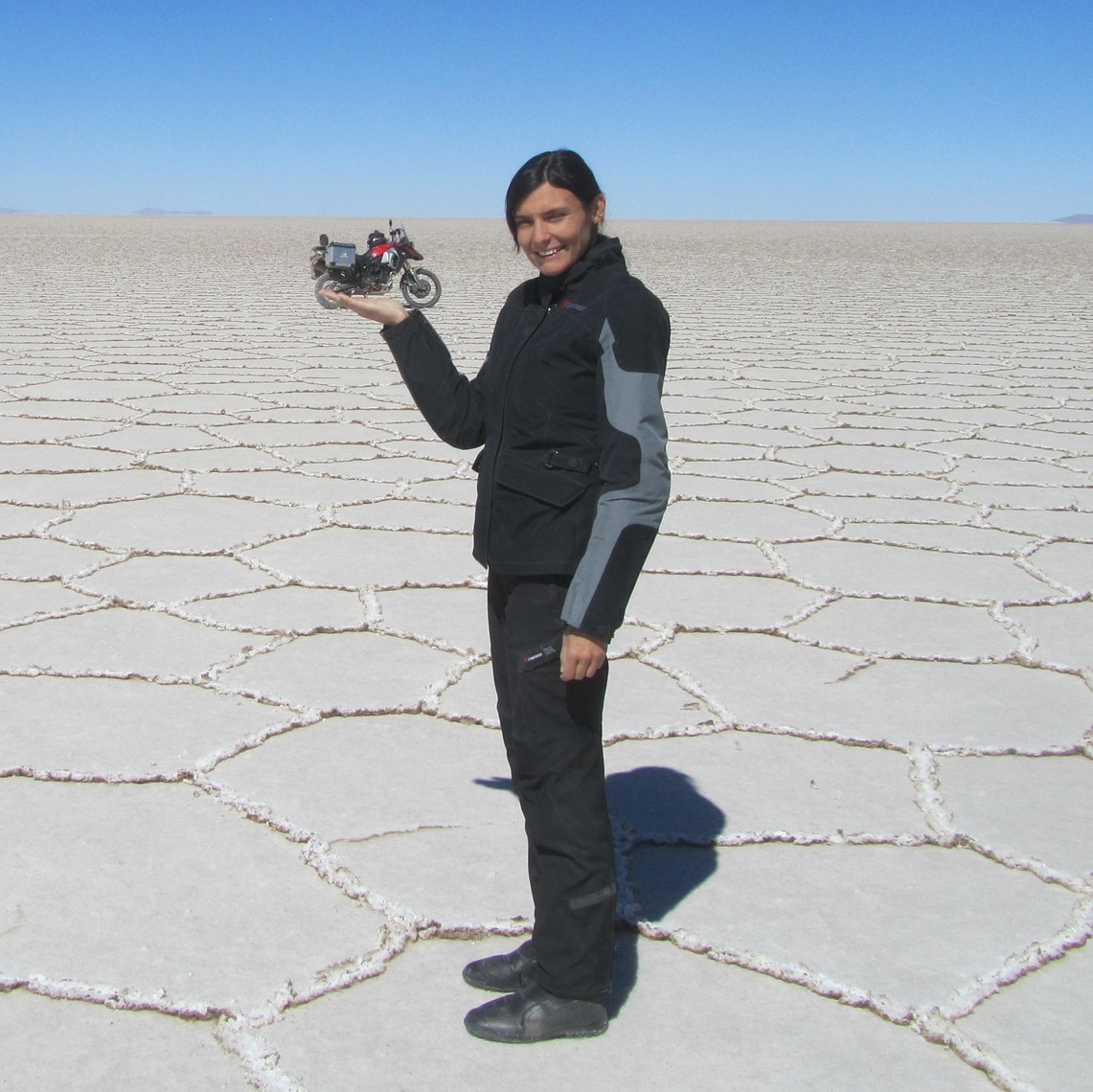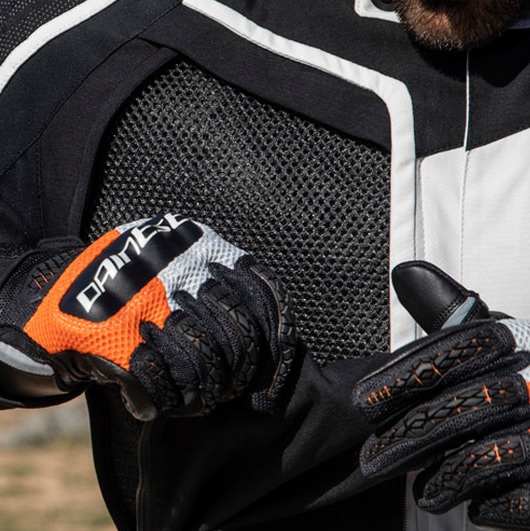
Hi, I’m Cristina. I love traveling and I’ve been adding two wheels to the equation of that passion since I came to Dainese. What better way to discover new worlds, to be caught up in the wonder of nature, feeling part of what you see, without barriers? Websites and blogs give you a lot of information to help you prepare, but the unexpected crops up when you’re on the spot, too. Those are the most challenging and intense moments, because it brings out ingenuity and the good in people.
“A journey does not begin when we set off, nor does it end when we reach our destination. It actually begins much earlier and never ends, as our tape of memories continues to run in our heads long after we’ve stopped."
I’m not a writer, but I will try to tell you in my own words about the emotions I experienced during a motorcycle trip that two of us made to South Africa and Namibia. The winter period is the most suitable for travel here, as there is almost zero rainfall and the average temperature is 77 °F. Temperatures in South Africa are slightly lower than in Namibia, but still pleasant and ideal for riding.
We visited GS Africa Motorcycle Rentals & Tours in Cape Town, where we rented a BMW F800 GS Adventure. We opted for the Adventure version so that we’d have greater range and avoid any refueling problems. From our very first interaction, the agency helped us create our tailor-made trip, providing advice about stops and places not to be missed. Even in the era of satellite navigators and GPS, it’s important for us to leaf through a good guide like Lonely Planet and a map like the Freytag & Berndt 1: 1,000,000, inconvenient to open en route perhaps (and to close again if there’s wind), but very detailed. We essentially had to decide on our stops ahead of time, mainly because we’ve decided not to sleep under the stars with a tent in the company of wild animals, but our route is nevertheless very varied in terms of landscape.
The adventure starts with our arrival in Cape Town. The capital deserves to be explored on foot, so that we can admire the Dutch colonial and Victorian style buildings that coexist with the modern skyscrapers and lush botanical gardens. And we can’t miss the bright colors of the facades in the Malaysian district of Bo-Kaap, all overlooked by the grandeur of Table Mountain and Lion's Head. To end the day, we take a cable car up wonderful Signal Hill and enjoy the beautiful sunset. For dinner, we highly recommend tapas at Chefs Warehouse Winebar & Pinchos, 92 Bree St, right next to the Cape Heritage Hotel.
via C13 3h 20m/325km - 155km of dirt road via C13 from Noordoewer to Rosh Pinah, 170km of asphalt via C13 to Aus
(125km+125km/tot. 3h via B4, a ribbon of asphalt that crosses the desert)
In the morning we take the B4 which heads towards the coast, crossing the desolate southern Namib landscape. The area is characterized by mountain ranges and wide expanses where the famous wild desert horses roam.
Towards the coast the wind shifts the sand so much that it’s impossible to identify the paved road in many places. We must be careful here, as the piles of sand can reach considerable heights and invade the road. It is not uncommon to see workers removing them in fact.
We stop to visit the ghost town of Kolmanskop. The atmosphere is surreal. Year after year, the sand devours the houses and swallows up every memory of this long-abandoned mining town. In our riding gear, we look like two astronauts who’ve landed on a distant planet.
We get back in the saddle and continue to the coastal town of Lüderitz, crossing land that belongs to the diamond mining companies. The street names are still in German, a legacy of the former colonial domination in the late 1800s. It actually looks like a corner of old Europe, but in a place you wouldn't expect to find it. We choose a restaurant with a terrace overlooking the sea and enjoy some good grilled fish. We then head back towards Aus, retracing the same route we took earlier. There aren’t many options as we’ve said, unless you venture to places where access is not allowed (National Diamond Coast, National Park) or get lost in the sand dunes.
(via C27) (Namib-Naukluft National Park) - 6h/375km dirt road
We’re back in the saddle early again. Today’s going to be tough, as we’ve heard the road ahead described as being like a "washing machine". When we’re not bouncing around too much, I have fun taking pictures of the wild animal signs. After all, we don’t often get to see "beware, giraffes crossing"!
As a final destination, we couldn’t miss the view of the wonderful red dunes of Sossusvlei in the Namib Naukluft Park, one of the iconic images of Namibia. Here is our shot of the famous Dead Vlei, a forest of age-old petrified acacias, the very dark color of which contrasts with the white of the soil and the orange of the dunes. One piece of advice... We were sure we could ride all the way to the dunes, but as this is a National Park it is forbidden to enter on two wheels, as is often the case in both Namibia and South Africa. After all, there is a lot of sand and a real risk of getting stuck. It’s best to opt for an organized tour with a jeep and an expert driver. We booked such a trip via the Sossusvlei Lodge hotel in Sesriem. In the evening, it’s an alfresco dinner under a breathtaking starry ceiling.
We usually prefer to travel alone and not abandon our trusty vehicle, but there are some places where it’s best to rely on an expert guide, both for the lay of the land and the many things we can learn by doing so. To visit Moon Valley in the Namib desert we book a tour with the Kallisto agency and enjoy listening to Hans' interesting anecdotes. With his jeep, he takes us to explore the many endemic plant species. I didn't think a desert landscape could be so lush! The words that stick with us are Welwitschia mirabilis, the name of a thousand-year-old plant with an unusual shape.

5h/500km via C10, B1, N7 (80km dirt road to B1, then asphalt)
The next day we leave for South Africa. This is the section of the route on which we feel the most free and the most lost at the same time. In front of us the line of the horizon is clear, with blue skies dotted with a few white clouds above, and an endless expanse of sand below. And all around, Africa, in all its purity.
On previous days, we travelled hundreds of miles without meeting anyone. Shortly after crossing the border, fate has it that we get a puncture. Unfortunately the puncture kit doesn’t solve the problem. So we ask for help at the Letsatsi Lodge hotel where we’ve booked for the night. And like a guardian angel, the legendary Willy, a painter with a passion for motorbikes, comes to save us in the middle of nowhere with his trailer. He takes us to the local mechanic for the repair. Every person we've come across has always been kind to us. Before asking for any kind of information it’s polite to ask "How are you Sir/Madam?" A nice "how are you?" is always a good way to start a conversation.
overnight stay near Langeban
We continue south and suddenly a breathtaking spectacle appears... the days have warmed up since we started out and the desert has begun to bloom! Namaqua National Park, located in Northern Cape Province, is covered in multicolored flowers. A riot of bright color, from orange to fuchsia, extends across the usually arid land. A truly unique ecosystem!
The stretch of coast through the West Coast National Park is not to be missed. Thunderous waves crash onto the shore, while flocks of pink flamingos stop in the serene lagoons nearby. It’s difficult to capture the poetry of the place in words or with a click of the camera.